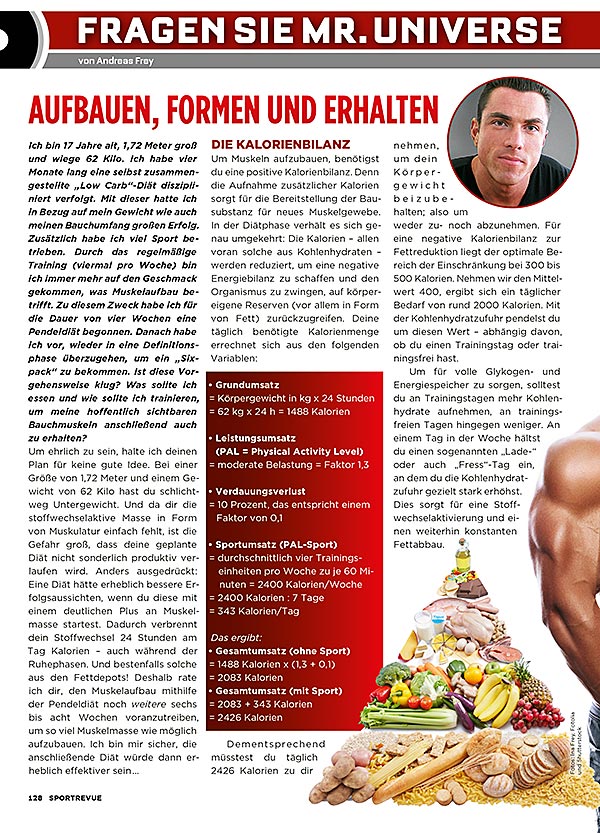COLUMN 82 |
BUILD, SHAPE AND MAINTAIN

HOW TO ACHIEVE MAXIMUM SUCCESS USING CALORIE BALANCE.
Through regular training (four times a week) I have developed a taste for building muscle. To this end, I have started a four-week commuter diet. After that, I plan to go back into a definition phase to get a "six-pack". Is this a smart approach? What should I eat and how should I train to maintain my hopefully visible abdominal muscles afterwards?
ANSWER

THE CALORIE BALANCE
To build muscle, you need a positive calorie balance. This is because the intake of additional calories provides the building material for new muscle tissue.In the diet phase, the opposite is true: calories - especially those from carbohydrates - are reduced in order to create a negative energy balance and force the organism to use its own reserves (mainly in the form of fat). The amount of calories you need each day is calculated from the following variables:
? BASIC METABOLISM
= BODY WEIGHT IN KG X 24 HOURS= 62 KG X 24 H = 1488 CALORIES
? PHYSICAL ACTIVITY LEVEL (PAL)
= MODERATE LOAD= FACTOR 1.3
? DIGESTIVE LOSS
= 10 PERCENT= THIS CORRESPONDS TO A FACTOR OF 0.1
? SPORTS SALES (PAL-SPORT)
= AN AVERAGE OF FOUR TRAINING SESSIONS PER WEEK, EACH 60 MINUTES= 2400 CALORIES/WEEK
= 2400 CALORIES : 7 DAYS
= 343 CALORIES/DAY
THAT MAKES:
? TOTAL SALES (EXCLUDING SPORTS)
= 1488 CALORIES X (1.3 + 0.1)= 2083 CALORIES
? TOTAL SALES (INCLUDING SPORTS)
= 2083 + 343 CALORIES= 2426 CALORIES
To ensure that your glycogen and energy stores are full, you should consume more carbohydrates on training days and less on non-training days. One day a week you should have a so-called "loading" or "feeding" day, on which you deliberately increase your carbohydrate intake significantly. This ensures that your metabolism is activated and that you continue to burn fat at a constant rate.
SEND US YOUR QUESTION!
Do you have any questions about bodybuilding, nutrition, training or supplements? Then send us your question by email to: INFO@FREYNUTRITION.DEThis will then be answered personally by Andreas Frey in the form of a column and published here!











